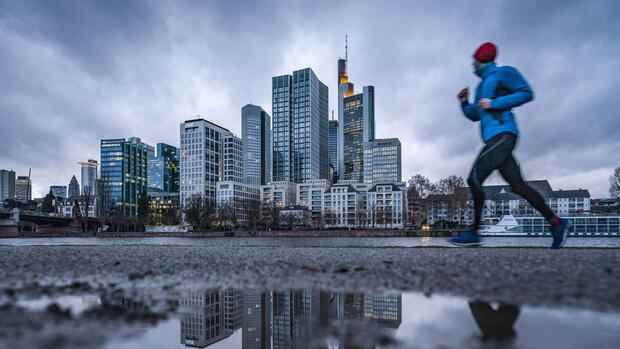Early risers (larks) in particular benefit from a morning exercise routine. Those who get up late, on the other hand, are still productive in the evening.
(Photo: dpa)
A few years ago, boxer Wladimir Klitschko said he didn’t know why, but that endurance runs before breakfast were ideal for him to lose weight. What the former world champion was still groping about in the dark is now being researched quite intensively. When is the best time of day for which physical activity, when is it particularly effective? More and more studies are asking these questions.
The answers are quite relevant. Managers in particular know that they are aware of the importance of exercise as a key remedy against diseases of civilization such as high blood pressure, obesity, diabetes mellitus, heart attack and stroke, and that sport is therefore high on the to-do list for most people.
The only thing is that there isn’t enough time because of all the professional tasks. And overcoming your weaker self isn’t always easy either. It helps to know when planning the day when training is most beneficial.
It turns out that there is (unfortunately) no simple answer. The ideal time for training is always linked to the body’s internal clock. And this ticks individually differently. The biorhythm and our sleep-wake behavior are controlled in the diencephalon.
Top jobs of the day
Find the best jobs now and
be notified by email.
Two important hormones are formed there. Once melatonin, the “sleep hormone” makes us tired and ensures a good night’s sleep. On the other hand, serotonin, it makes us awake and fresh.
Daylight is crucial
Many people who want to train make the mistake of underestimating this connection to training efficiency. The most important factor is daylight. Studies have shown that performance can vary by around 26 percent over the course of the day. The so-called “larks” wake up early and are tired relatively early in the evening.
As early risers, “larks” have a high cortisone level in the morning, which increases blood pressure, pulse, body temperature and testosterone levels. During this period, most of the red blood cells are also on their way in the skeletal muscles.
The morning is therefore the best time for intensive endurance training for “Lerchen”, for example after a coffee and before work. Because of the high testosterone level, strength training in the morning also makes sense for “larks”. Morning grouches (“owls”) should therefore not train in the morning, the mind rightly resists.
Most people have a low point in the afternoon between 1:00 p.m. and 3:00 p.m. You feel tired. The metabolic processes run on the back burner. A lot of blood is in the gastrointestinal tract and is needed for digestion. This draws blood from the muscles. This is when the risk of injury is greatest. However, individual sports such as light forms of yoga with low stress intensity or even a brisk walk during the lunch break can be practiced well.
After the midday slump, there is another phase with increasing willingness to perform and a significantly higher blood pressure. This happens between 3pm and 4pm. Good for sports that require coordination and flexibility. Also ideal for skating and cycling. This time window has positive effects on concentration and coordination.
Strength training in the evening
For competitions, the best time is between 5:00 p.m. and 7:00 p.m. Our body is in top form. Testosterone also increases again. The early evening is also suitable for strength training.
The temperature of the muscles is at its highest at this time. This is crucial for accelerating metabolic processes and also for providing energy. Similar effects can also be achieved through warm-up training.
You shouldn’t exercise late at night. This would lead to restless sleep. The “owls”, which get tired relatively late and can fall asleep, are still very productive in the evening.
This guy can still exercise later because he still has time to slow down afterward.
Statistical reports tell us that the preferred time of day to exercise at the gym is in the evening. There are certainly many early risers among them, for whom sport in the evening is not ideal.
The night is then used for regeneration. We see the highest levels of melatonin in the blood. Cortisone is at a minimum. Growth hormones increase significantly. That’s why muscle building is happening now.
Biorhythms, genes and the question of what type we are define the best time for training. We just have to be aware of it.
Conclusion:
- The optimal training time is largely determined by our natural biorhythm.
- The best training time is strongly influenced by the individual. There is no general best time.
- “Larks” train best early in the morning before work or in the late morning.
- The best training time for “owls” is in the late afternoon and evening hours.
- The body is able to perform at its best between 10:00 a.m. and 12:00 p.m. and between 5:00 p.m. and 7:00 p.m.
- The afternoon is the ideal time for strength training and technical sports.
- Training is most ineffective at lunchtime.
- Exercising too late in the evening disturbs the sleep rhythm and jeopardizes regeneration.
- The attempt to shift the individual biorhythm does not work and is therefore counterproductive.
More: How healthy are trips into space?
Curt Diehm is medical director of the Max Grundig Clinic, which specializes in executives. The internist also teaches as an adjunct professor at the University of Heidelberg and is the author of over 200 original scientific publications and many non-fiction books.
